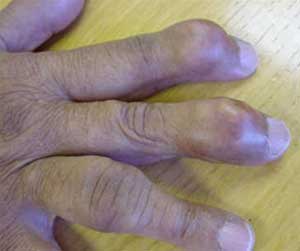Dietary adjustments alone cannot provide significant benefits for managing gout; therefore, medication remains the best approach to treat this condition. In addition to anti-inflammatory medications and those addressing other symptoms during acute stages, it is essential to have medications that target metabolic issues causing elevated uric acid levels in the blood.
 |
|
Symptoms in the hands of gout patients |
The condition of elevated uric acid levels in the blood can occur when the body produces too much uric acid or fails to excrete it adequately. Current medications address both causes of increased uric acid levels.
Purines break down into uric acid crystals, which accumulate in soft tissues and joints, leading to pain associated with gout. A dietary approach to managing gout aims to reduce uric acid levels in the body while also managing other common conditions in gout patients, such as diabetes, high cholesterol, hypertension, and atherosclerosis.
The recommended diet typically includes low-purine foods; however, completely avoiding purines is not feasible, and only limitation is possible. Patients need to learn through trial and error, where each mistake serves as a lesson to identify which foods trigger issues. Dr. Laurent Rall, a nutrition expert at Tufts University in Boston, states: “Start by eliminating high-purine foods and gradually reduce medium-purine foods. If you do not experience gout pain with such a diet, you can add medium-purine foods back in or sometimes try higher-purine foods. This way, you can determine your safe level of purines and still enjoy your favorite dishes without pain.”
High-purine foods include all alcoholic beverages (which raise uric acid levels in the blood by hindering uric acid excretion), certain fish, seafood, and shellfish (such as clams, oysters, mussels, crab, shrimp), cod, scallops, salmon, and certain types of salted meats like bacon, turkey, veal, and organ meats (such as intestines, liver, etc.).
Medium-purine foods include beef, chicken, goose, pork, and ham; crab, lobster, oysters, and shrimp; as well as vegetables and legumes like asparagus, green beans, lentils, lima beans, mushrooms, and spinach.
Medication Treatment:
With proper treatment, most individuals with gout can manage their symptoms and maintain a normal lifestyle. Gout can be treated with one or more medications in combination.
The most commonly used medications for acute attacks are high doses of non-steroidal anti-inflammatory drugs (NSAIDs) taken orally or corticosteroids given orally or injected into the affected joint. NSAIDs reduce inflammation caused by uric acid accumulation but do not affect overall uric acid levels in the body. Frequently prescribed NSAIDs include indomethacin (Indocin), naproxen (Anaprox, Naprosyn), taken daily.
Corticosteroids are powerful anti-inflammatory hormones, commonly prednisone. Patients often feel relief within hours, and the acute pain subsides completely within a week. When NSAIDs or corticosteroids fail to control symptoms, colchicine may be used, which is most effective when administered within the first 12 hours of an acute attack; colchicine can be taken every hour until pain relief is achieved.
For some patients, either NSAIDs or low-dose colchicine may be taken daily to prevent recurrent acute attacks. Allopurinol (Zyloprim) or probenecid (Benemid) can be used to treat high uric acid levels in the blood and to reduce the frequency of acute attacks and the development of uric acid crystals.
Dr. Dao Xuan Dung


















































